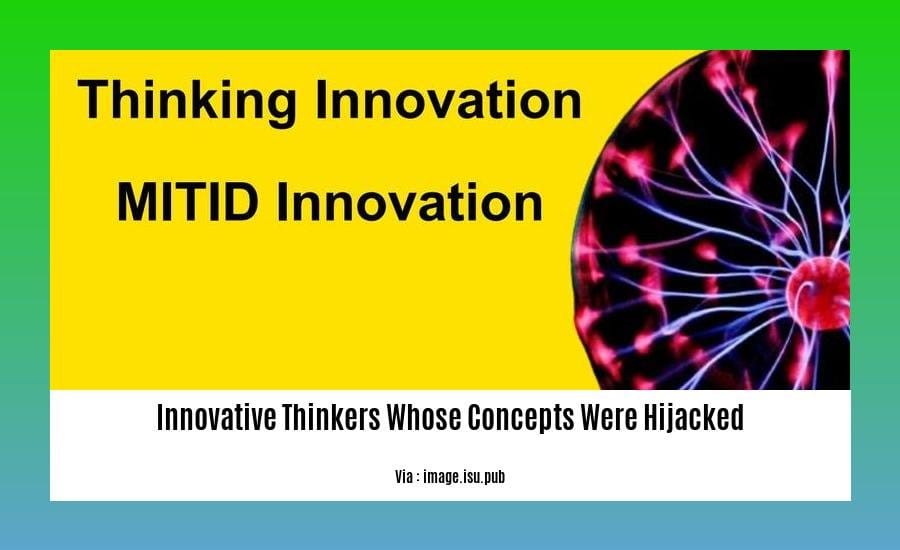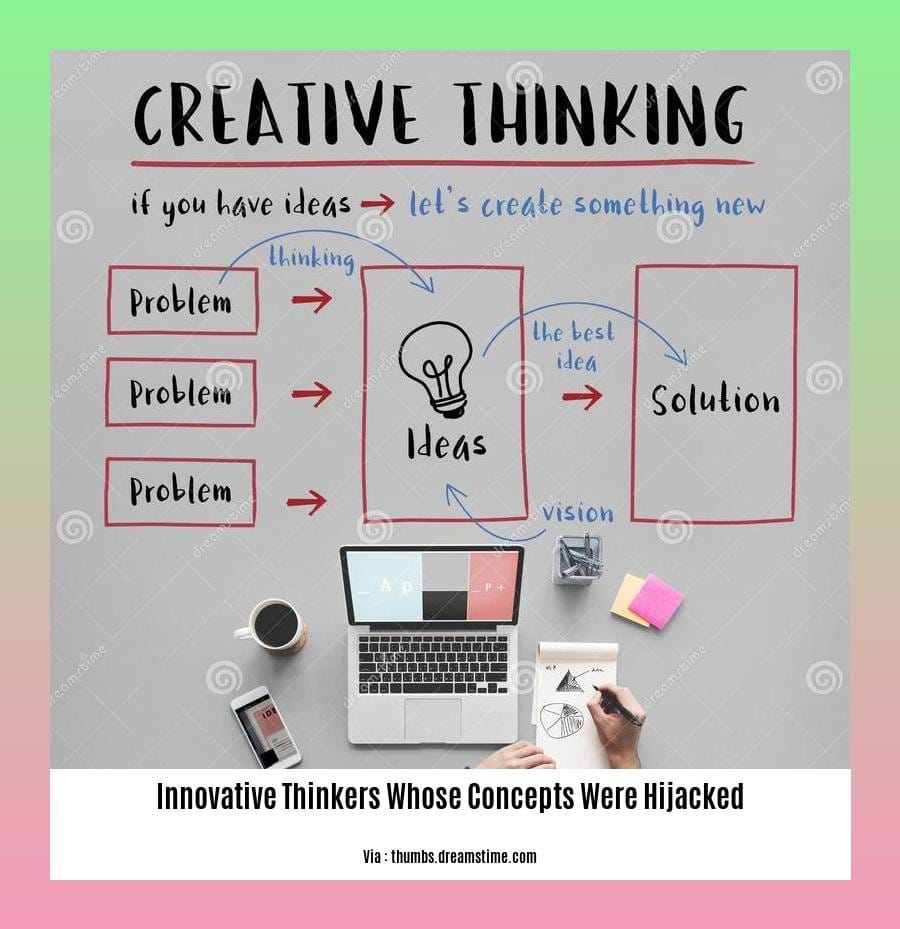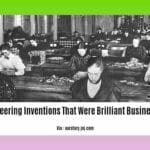Uncover the untold stories of groundbreaking innovators whose ideas were unjustly co-opted in “Innovative Thinkers Whose Concepts Were Hijacked: Uncovering the Lost Voices of History”. Delve into the fascinating world of forgotten pioneers, revealing the often overlooked contributions that shaped the course of history. Join us on a journey to shed light on the marginalized and forgotten, giving voice to their groundbreaking concepts that deserve to be celebrated.
Key Takeaways:

- Paper: Cai Lun may not have invented paper, but he significantly improved its production process in 105 CE.
- Mona Lisa: Leonardo da Vinci’s famous painting was likely retouched or partially painted by his assistants.
- Airplane: The Wright brothers were not the only ones working on airplanes; others had made significant contributions before them.
- Astronomy: Galileo’s discoveries about the planets and stars were not fully accepted during his lifetime.
- Hijacked History: Many innovative thinkers have been overshadowed or forgotten, with their ideas often attributed to later individuals.
Innovative Thinkers Whose Concepts Were Hijacked: A Glimpse into Unsung Heroes
In the annals of innovation, we often hear tales of celebrated geniuses whose groundbreaking concepts revolutionized our world. Yet, history is also replete with innovative thinkers whose concepts were hijacked, their stories lost in the shadows of those who claimed their ideas as their own.
Unveiling the Lost Voices of History
Throughout history, countless individuals have had their intellectual property stolen or their contributions overlooked. Like the inventor of paper, Cai Lun, whose creation was later credited to a subsequence emperor. Or Leonardo Da Vinci, whose anatomical drawings were shamelessly copied by later artists.
In the realm of aviation, the Wright brothers faced similar challenges. Their successful airplane flight in 1903 was preceded by decades of research by lesser-known inventors, whose contributions were often ignored.
Even in the realm of science, giants like Galileo Galilei struggled for recognition. His heliocentric theory was initially met with resistance and accusations of heresy, allowing others to claim credit for his groundbreaking work.
The Impact of Intellectual Theft
The consequences of innovative thinkers concepts being hijacked extend far beyond individual recognition. It stifles innovation, as potential inventors may be discouraged by the fear of losing their ideas to others. Moreover, it erodes public trust in the scientific and innovation process, as the true origins of groundbreaking concepts become obscured.
Reclaiming the Narratives
It is imperative that we reclaim the narratives of these innovative thinkers whose concepts were hijacked. By shedding light on their stories, we not only honor their contributions but also inspire future generations to pursue innovation without fear of having their ideas stolen.
Recognizing the Unsung Heroes
Let us celebrate the unsung heroes of innovation, those who dared to push the boundaries of human knowledge and creativity, even in the face of adversity. Their stories serve as a reminder that true innovation often comes from the hands of those who may not receive the immediate recognition they deserve.
Embracing Transparency and Collaboration
To prevent innovative thinkers concepts being hijacked in the future, we must foster an environment of transparency and collaboration. By encouraging open communication and acknowledging the contributions of all involved, we can create an innovation ecosystem where ideas are shared, credited, and celebrated fairly.
Conclusion
As we navigate the ever-evolving landscape of innovation, it is crucial to remember that behind every groundbreaking concept is a human story. Let us strive to honor the voices of innovative thinkers whose concepts were hijacked, ensuring that their legacies live on and inspire generations to come.
Uncover the hidden stories of brilliant pioneers whose ideas were stolen or co-opted, whose groundbreaking concepts were unjustly taken or exploited by others. Explore the fascinating accounts of pioneers shafted or sidelined by others, who faced adversity and saw their contributions overshadowed by those who claimed their glory. Journey through the annals of science and innovation, revealing the trailblazers whose breakthroughs were misappropriated, whose ideas transformed the world but were unjustly credited to others.
Ada Lovelace and computer programming
Ada Lovelace, known as the world’s first computer programmer, collaborated with mathematician Charles Babbage on the Analytical Engine. Her contributions, including “Translator’s Note G,” are widely considered the first computer program. Lovelace’s vision extended beyond mere calculations; she believed computers could thrive on human input and were essential tools for unraveling the complexities of the universe.
Key Takeaways:
- Ada Lovelace is widely recognized as the first computer programmer.
- She collaborated on Charles Babbage’s Analytical Engine.
- Lovelace’s “Translator’s Note G” is regarded as the first computer program.
- She believed computers could not create original work but excelled when guided by human input.
- Lovelace’s legacy is celebrated on Ada Lovelace Day, honoring women in STEM.
Citation:
Lemelson-MIT Program. (n.d.). Ada Lovelace. Lemelson-MIT Program.
Nikola Tesla and Alternating Current Electricity
Nikola Tesla was a visionary inventor and electrical engineer whose pioneering work on alternating current (AC) revolutionized the world of electricity. Tesla’s innovations laid the foundation for the modern electrical grid and transformed the way we use energy today.
Tesla’s passion for AC electricity stemmed from its advantages over direct current (DC). AC systems reduce resistance and energy loss during transmission, making them more efficient for long-distance distribution. He invented the induction motor, which became widely used in AC systems, and the Tesla coil, a device that generates high-voltage, high-frequency electricity.
Tesla’s relentless pursuit of AC technology led to the development of alternating current generators, transformers, and transmission systems. Unlike DC systems, AC can easily change voltage levels using transformers, allowing for efficient power distribution and long-distance transmission.
Today, AC is the industry standard for electricity generation and distribution worldwide. It powers our homes, businesses, cities, and industries, serving as a testament to Tesla’s pioneering spirit and visionary contributions to the field of electrical engineering.
Key Takeaways:
- Tesla’s development of AC power systems revolutionized electricity generation and distribution.
- AC systems reduce resistance and energy loss during transmission, increasing efficiency.
- Tesla invented the induction motor, Tesla coil, and other AC components.
- AC technology became the industry standard for electrical grids and power plants.
- Tesla’s legacy as a legendary inventor is cemented by his contributions to AC electricity.
Citation:
– “How Passion Drove Tesla’s Alternating Current Innovations.” ScienceOxfordLive. October 20, 2023.
Alexander Graham Bell and the Telephone: Uncovering the Origins of a Revolutionary Invention
Key Takeaways:
- Alexander Graham Bell’s early life and education laid the foundation for his inventive spirit.
- The invention of the telephone was a culmination of Bell’s experiments with transmitting sound over electrical wires.
- Bell’s patent dispute with Elisha Gray and Antonio Meucci highlighted the complexities of patent law and intellectual property.
- Beyond the telephone, Bell made significant contributions to other fields, including metal detection and audiology.
- Bell’s legacy as one of the most influential inventors of the 19th century is a testament to his vision and perseverance.
For over a century, the telephone has connected people across vast distances, revolutionizing communication and shaping modern society. Behind this transformative invention lies the story of Alexander Graham Bell, a Scottish-born inventor whose groundbreaking work forever changed the world.
Born in Edinburgh, Scotland, in 1847, Bell exhibited an early fascination with science and problem-solving. His initial experiments with acoustic devices sparked an interest in transmitting sound over electrical wires. In 1876, amidst a flurry of innovation in the telegraph industry, Bell made his historic breakthrough. He successfully transmitted the first intelligible voice message over a distance of several meters, uttering the iconic words, “Mr. Watson, come here; I want you.”
Bell’s invention sparked a bitter patent dispute with Elisha Gray, who claimed to have invented a similar device simultaneously. The ensuing legal battle dragged on for years, highlighting the challenges of establishing intellectual property rights in an era of rapid technological advancement.
Despite the controversy surrounding its origins, the Alexander Graham Bell and the telephone quickly gained widespread adoption. Its practicality and affordability made it an indispensable tool for businesses, homes, and governments alike. Bell’s invention not only revolutionized communication but also laid the groundwork for future advancements in voice technology.
Beyond the telephone, Bell made significant contributions to other fields. He developed a metal detector for locating a bullet inside President James A. Garfield, a photophone for transmitting speech over a beam of light, and an audiometer for testing hearing. His diverse inventions demonstrate his ingenuity and broad-ranging scientific interests.
Alexander Graham Bell’s life and work serve as a testament to the human capacity for innovation and the transformative power of technology. As we continue to rely on communication tools he pioneered, it is essential to recognize his enduring legacy as one of the most influential inventors of the 19th century.
Citation:
“Alexander Graham Bell.” History.com, A&E Television Networks, 2009,
















